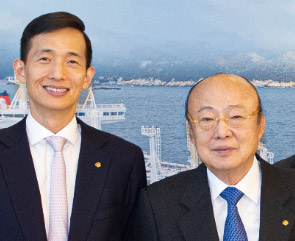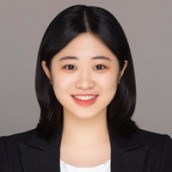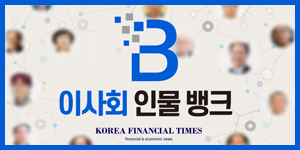
From Left: Kim Dong-kwan, Vice Chairman of Hanwha Group, and Kim Seung-youn, Chairman of Hanwha Group
Kim Dong-kwan, Vice Chairman of Hanwha Group, demonstrates leadership and decisiveness that closely resemble those of his father, Chairman Kim Seung-youn. In fact, Vice Chairman Kim is retracing the path his father walked 30 years ago.
The father-son duo, Kim Seung-youn and Kim Dong-kwan, both made pivotal moves at the age of 41. Despite living in different eras, their lives reflect a parallel theory of shared destiny.
Born in October 1983, Vice Chairman Kim Dong-kwan turned 41 this year. Last month, Hanwha Aerospace, under his leadership, announced plans for a capital increase through rights issuance. The move aims to expand overseas production bases and elevate the company to a top-tier position in global defense, shipbuilding, and aerospace industries.
Out of the KRW 3.6 trillion raised through the rights issuance, KRW 2.4 trillion will be allocated overseas. Specifically, KRW 1 trillion will be used to establish local factories for enhancing overseas defense production capabilities, KRW 600 billion for joint ventures (JVs) with foreign defense companies, and KRW 800 billion for acquiring stakes in overseas shipbuilding companies.
Among these allocations, approximately KRW 30 billion is required immediately this year to set up a JV with a Saudi Arabian defense company. Additional investments will follow sequentially: KRW 1.31 trillion in 2026, KRW 580 billion in 2027, and KRW 480 billion in 2028. It will take about three to four more years to fully utilize the funds raised through the rights issuance.
Chairman Kim Seung-youn also was reshaping Hanwha Group at the age of 41. In 1994, he declared a "second founding" of the group and diversified its business portfolio from explosives and heavy industries into petrochemicals and services. He acquired Hanyang Chemical (now Hanwha Solutions Chemical Division) and bought foreign stakes in Kyungin Energy (now Hanwha Energy), transforming Hanwha into one of Korea’s leading petrochemical companies.
Despite opposition from those around him, Chairman Kim boldly acquired Hanyang Chemical, which was struggling with Tens of billions of won in losses at the time. Within a year, he turned the company profitable.
He also rebranded Korea Explosives Group as Hanwha Group and reorganized all affiliates by 1995. Hanwha’s assets grew from KRW 500 billion in 1981 to KRW 5 trillion in 1991 and further to KRW 8 trillion by 1995.
The dramatic transformation from explosives to petrochemicals over the past 30 years has continued, evolving into a global top-tier defense, shipbuilding, and aerospace powerhouse.
This is the background behind Hanwha Aerospace’s move to carry out the largest rights offering ever by a Korean company.
The "parallel theory" between Kim Seung-youn and Kim Dong-kwan appears to be nearing completion. In response to market speculation that Hanwha Aerospace's rights issuance might be linked to family succession plans, Chairman Kim Seung-youn last month transferred nearly half of his stake in Hanwha Corporation—the group’s holding company—to his three sons: Vice Chairman Kim Dong-kwan, President Kim Dong-won, and Executive Vice President Kim Dong-sun. With this transfer, the three brothers now collectively hold shares in Hanwha Corporation, effectively finalizing the group's succession process.
Hanwha Group clarified that "the stock transfer was intended to ensure that Hanwha Aerospace's rights issuance is not associated with succession plans," adding that "the acquisition of Hanwha Ocean shares by Hanwha Aerospace is also unrelated to succession but rather part of a strategic initiative for global land-sea-air defense package operations."
Shin Haeju (hjs0509@fntimes.com)



























![“메가 LCC가 온다” 제주항공 vs 진에어, 진짜 대결은 이제부터 [주목 이 기업]](https://cfnimage.commutil.kr/phpwas/restmb_setimgmake.php?pp=006&w=69&h=45&m=5&simg=2025040513470800346dd55077bc212411124362.jpg&nmt=18)
![보험사, 관료 출신 사외이사 영입 러시…회계 등 제도변경 대응 [사외이사 줌人 (1)]](https://cfnimage.commutil.kr/phpwas/restmb_setimgmake.php?pp=006&w=69&h=45&m=5&simg=2025040517151405071dd55077bc212411124362.jpg&nmt=18)
![신동훈 갤럭시아머니트리 대표, 내실경영에 '흑자'…올해 선불카드·STO로 성장 페달 [2024 금융사 실적]](https://cfnimage.commutil.kr/phpwas/restmb_setimgmake.php?pp=006&w=69&h=45&m=5&simg=2025032815460700193957e88cdd512116082156.jpg&nmt=18)


![12개월 최고 연 3.20%…수협은행 ‘Sh첫만남우대예금’ [이주의 은행 예금금리-4월 1주]](https://cfnimage.commutil.kr/phpwas/restmb_setimgmake.php?pp=006&w=69&h=45&m=5&simg=20250404165639061515e6e69892f1439255124.jpg&nmt=18)
![증권사 이사회 의장 분리 48%…내부통제위 법률가 수혈 [사외이사 줌人 (1)]](https://cfnimage.commutil.kr/phpwas/restmb_setimgmake.php?pp=006&w=69&h=45&m=5&simg=2025040513485204164dd55077bc212411124362.jpg&nmt=18)
![‘내부통제 중심’ 금융사 이사회, 사외이사 제 역할 못한다 [사외이사 줌人 (1)]](https://cfnimage.commutil.kr/phpwas/restmb_setimgmake.php?pp=006&w=69&h=45&m=5&simg=2025040513193400567dd55077bc212411124362.jpg&nmt=18)

![기관 '알테오젠'·외인 '펩트론'·개인 '에코프로' 1위 [주간 코스닥 순매수- 2025년 3월31일~4월4일]](https://cfnimage.commutil.kr/phpwas/restmb_setimgmake.php?pp=006&w=69&h=45&m=5&simg=2025040511503908718179ad439072211389183.jpg&nmt=18)












![[카드뉴스] KT&G ‘Global Jr. Committee’, 조직문화 혁신 방안 제언](https://cfnimage.commutil.kr/phpwas/restmb_setimgmake.php?pp=006&w=298&h=298&m=1&simg=202503261121571288de68fcbb3512411124362_0.png&nmt=18)


![[카드뉴스] 국립생태원과 함께 환경보호 활동 강화하는 KT&G](https://cfnimage.commutil.kr/phpwas/restmb_setimgmake.php?pp=006&w=298&h=298&m=1&simg=202403221529138957c1c16452b0175114235199_0.png&nmt=18)
![[카드뉴스] 신생아 특례 대출 조건, 한도, 금리, 신청방법 등 총정리...연 1%대, 최대 5억](https://cfnimage.commutil.kr/phpwas/restmb_setimgmake.php?pp=006&w=298&h=298&m=1&simg=20240131105228940de68fcbb35175114235199_0.jpg&nmt=18)
![[신간] 리빌딩 코리아 - 피크 코리아 극복을 위한 생산성 주도 성장 전략](https://cfnimage.commutil.kr/phpwas/restmb_setimgmake.php?pp=006&w=81&h=123&m=5&simg=2025032814555807705f8caa4a5ce12411124362.jpg&nmt=18)
![[신간] 지속 가능 경영, 보고와 검증](https://cfnimage.commutil.kr/phpwas/restmb_setimgmake.php?pp=006&w=81&h=123&m=5&simg=2025011710043006774f8caa4a5ce12411124362.jpg&nmt=18)
![[서평] 추세 매매의 대가들...추세추종 투자전략의 대가 14인 인터뷰](https://cfnimage.commutil.kr/phpwas/restmb_setimgmake.php?pp=006&w=81&h=123&m=5&simg=2023102410444004986c1c16452b0175114235199.jpg&nmt=18)

![[신간] 똑똑한 금융생활...건전한 투자와 건강한 재무설계 지침서](https://cfnimage.commutil.kr/phpwas/restmb_setimgmake.php?pp=006&w=81&h=123&m=5&simg=2025031015443705043c1c16452b012411124362.jpg&nmt=18)

![[카드뉴스] KT&G ‘Global Jr. Committee’, 조직문화 혁신 방안 제언](https://cfnimage.commutil.kr/phpwas/restmb_setimgmake.php?pp=006&w=89&h=45&m=1&simg=202503261121571288de68fcbb3512411124362_0.png&nmt=18)
![[AD] 기아, 혁신적 콤팩트 SUV ‘시로스’ 세계 최초 공개](https://cfnimage.commutil.kr/phpwas/restmb_setimgmake.php?pp=006&w=89&h=45&m=1&simg=2024123113461807771f9c516e42f12411124362.jpg&nmt=18)
![[AD] 아이오닉5 '최고 고도차 주행 전기차' 기네스북 올랐다...압도적 전기차 입증](https://cfnimage.commutil.kr/phpwas/restmb_setimgmake.php?pp=006&w=89&h=45&m=1&simg=2024123113204707739f9c516e42f12411124362.jpg&nmt=18)




